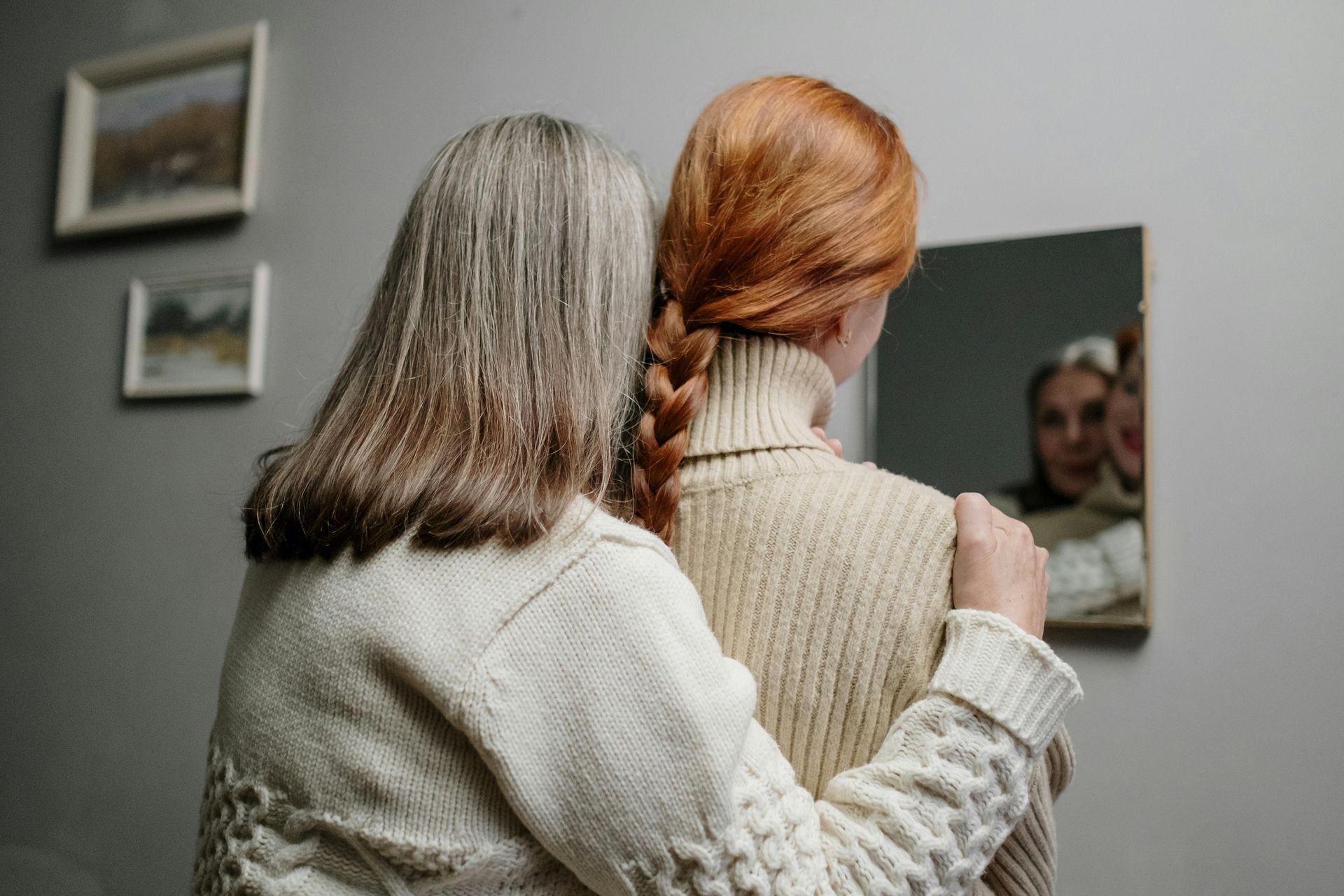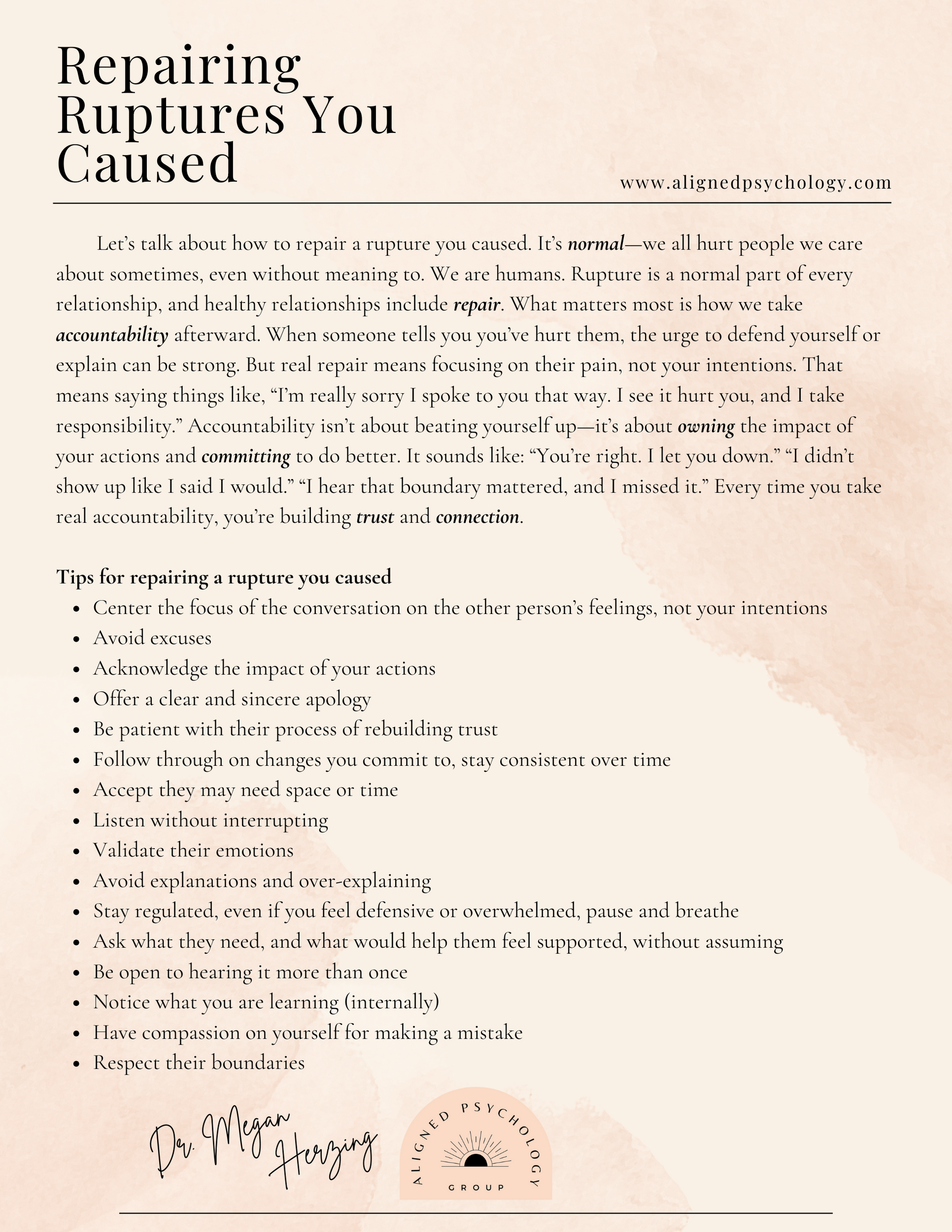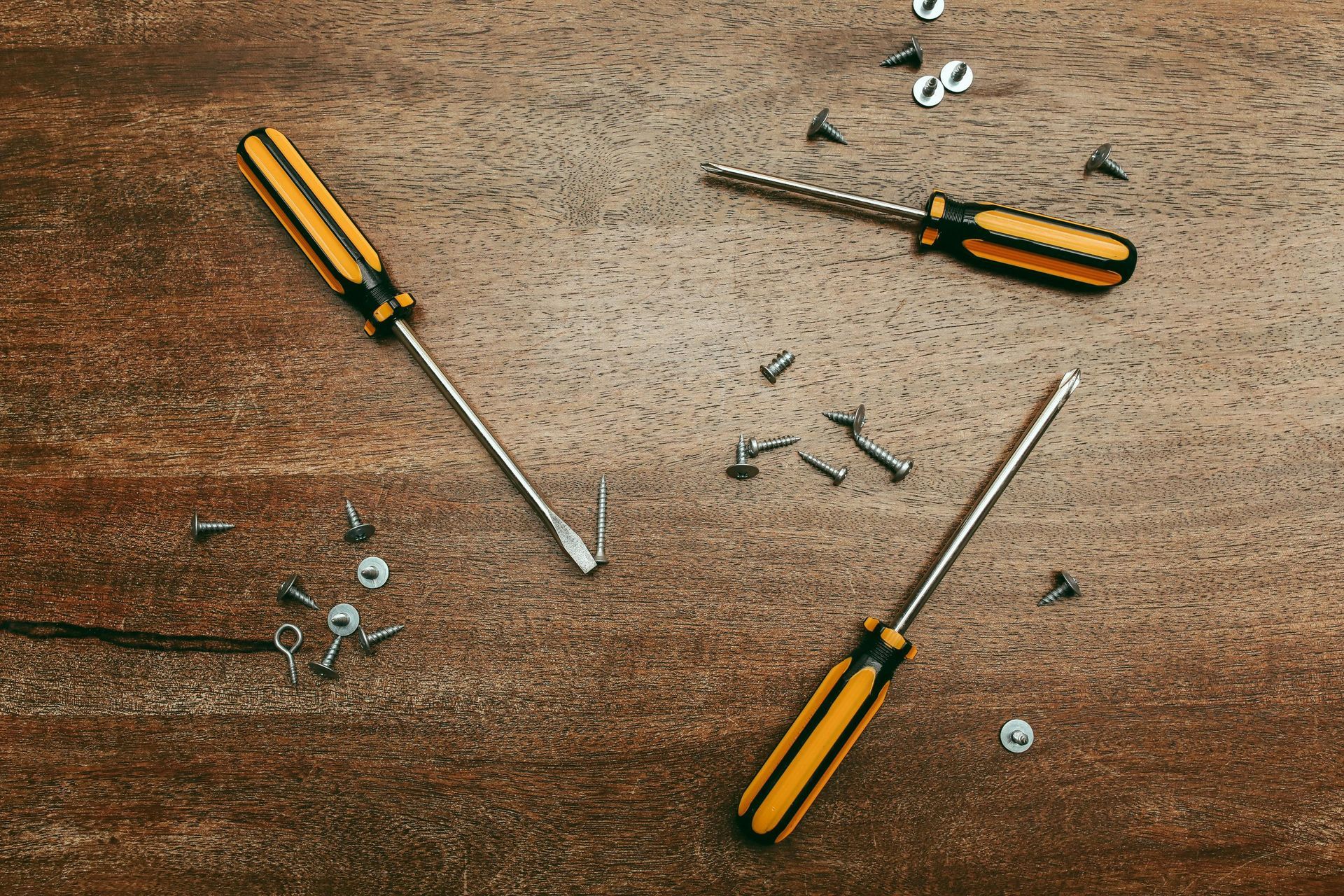Trauma Therapy Homework - Week 23
Week 23: The Basics (Relationship Mini Series)
Rupture and Repair
Welcome to Week 23 of your trauma therapy homework. This week, we’re diving into something that every relationship experiences: rupture and repair. Even the healthiest relationships have moments of conflict, disconnection, or hurt. That’s not the problem. The problem comes when those ruptures are ignored, avoided, denied, or left unhealed. And if you grew up in an environment where repair didn’t happen, you may not even know it’s possible—or how to start. Let’s break it down in a way that makes sense, and more importantly, feels do-able.

What Is a Rupture?
A rupture is a break in connection. It’s when something happens that creates a feeling of hurt, betrayal, misunderstanding, or emotional distance. It might be loud (like a fight or a cruel comment), or it might be quiet (like emotional withdrawal or shutting someone out). A rupture does not mean the relationship is doomed. Ruptures happen in all relationships! In fact, when handled with care, repairing a rupture can build deeper trust. But first, you have to know how to recognize when one has happened.
How to Identify a Rupture
You can often tell a rupture has happened by noticing both what’s going on around you and what’s happening inside you.
Externally, a rupture might look like:
- An argument that left things unresolved
- A boundary being crossed
- A sarcastic or hurtful remark
- Withdrawing or giving the silent treatment
- Feeling dismissed or minimized
In your body, a rupture might feel like:
- A pit in your stomach
- Sudden tension in your shoulders or jaw
- A lump in your throat
- A wave of shame, anger, or sadness
- A sense of disconnection or being misunderstood
The body often registers the rupture before the mind does. That sinking feeling? That sudden spike in heart rate? Those are clues.
10 Common Examples of Rupture
- Someone breaks a promise.
- You feel judged or criticized.
- A boundary you set is ignored.
- You receive the silent treatment or are emotionally shut out.
- Someone shares something personal you told them in confidence.
- You feel unseen, unheard, or invalidated.
- A person makes a hurtful joke at your expense.
- You're blamed for something unfairly.
- Someone lies to you, even about something small.
- A partner or friend forgets something important to you.
These are just examples, not an exhaustive list. Anything that disrupts your sense of emotional safety can feel like a rupture.

What Is Repair?
Repair is the process of reconnecting after a rupture. It’s how we acknowledge the pain or misstep, take responsibility, and work together to restore trust and safety. Repair is not about pretending the rupture didn’t happen or sweeping it under the rug. It’s about naming what happened, tending to the hurt, and showing up differently moving forward. When we engage in repair, we’re saying: “This relationship matters. Your feelings matter. I care enough to slow down and tend to the hurt between us.” Repair builds intimacy, strengthens trust, and teaches our nervous system that conflict doesn’t have to mean danger, rejection, or abandonment—it can be a path to deeper connection. True repair doesn’t require perfection. It just asks for presence, humility, and care. And the more we practice it, the more resilient our relationships become.

Repairing When Someone Else Has Ruptured With You
It is not your responsibility to repair a rupture that someone else caused. However, it is your responsibility to communicate about the rupture that happened and how it impacted you. When someone hurts you, the repair process begins with your own self-awareness. Check in with yourself. What are you feeling? What do you need? What part of you is most impacted? When you’re ready to approach the other person, keep the focus on your experience. Try using "I" statements instead of blame. For example, "When you raised your voice earlier, I felt overwhelmed and shut down. I want us to be able to talk without yelling." And here's the key: give them space to respond. Repair isn't about forcing someone to admit they're wrong. It's about seeking understanding, clarity, and if possible, reconnection.
Repairing When You Have Ruptured With Someone Else
If you're the one who hurt someone—whether intentionally or not—it can be hard to face. The natural urge is to defend, explain, or minimize. But true repair means being willing to see the impact of your actions, even when it’s uncomfortable. A good apology doesn’t start with "I didn’t mean to..." or "I was just..." It starts with presence and accountability. Try: "I see that what I said really hurt you. I take responsibility for that. It wasn’t okay." It’s about being willing to own your part and prioritize the relationship over your ego.
Tips for Repairing When You Are the One Who Caused the Rupture
- Center the focus of the conversation on the other person’s feelings, not your intentions
- Avoid excuses
- Acknowledge the impact of your actions
- Offer a clear and sincere apology
- Be patient with their process of rebuilding trust
- Follow through on changes you commit to, stay consistent over time
- Accept they may need space or time
- Listen without interrupting
- Validate their emotions
- Avoid explanations and over-explaining
- Stay regulated, even if you feel defensive or overwhelmed, pause and breathe. You don’t have to act from those emotions
- Ask what they need, and what would help them feel supported, without assuming
- Be open to hearing it more than once
- Notice what you are learning (internally)
- Have compassion on yourself for making a mistake
- Respect their boundaries
Apologizing Without Defensiveness
Apologies often get tangled in defense mechanisms. We say, "I'm sorry, but..." or "I was just trying to..." and suddenly the focus shifts from the hurt person back to us. Real apology means sitting with the discomfort of having hurt someone. It means resisting the urge to fix or explain it away. A true apology might sound like: "I'm really sorry I spoke to you that way. I see now that it hurt you, and I take responsibility for that." Defensiveness is natural, especially when we didn’t mean harm. But in repair, intention matters less than impact.
Taking Accountability
Accountability doesn’t mean beating yourself up or agreeing with everything the other person says. It means recognizing the effect your behavior had and choosing to do better.
Accountability sounds like:
- "You're right. I let you down."
- "I didn’t show up the way I should have."
- "That boundary mattered to you, and I ignored it."
It takes strength to own your impact, especially when shame wants to shut you down. But every moment of honest accountability is a step toward real connection.

Important Disclaimer About Rupture and Repair
The tools and strategies discussed in this post are intended for use within safe, respectful, and mutual relationships. Rupture and repair are a normal part of healthy connection. These strategies are not meant to be used in relationships that are abusive, manipulative, or toxic. If someone is consistently harming you, violating your boundaries, or using your vulnerability against you, attempting to repair can actually make you more unsafe. Safe people aren’t perfect, but they are willing to take accountability, engage in open dialogue, and make meaningful changes. They do not retaliate when you express hurt or use repair conversations to twist blame. If you're unsure whether a relationship is safe enough for repair work, this is something to explore with a trusted therapist or someone in your support system. Your well-being and emotional safety always come first.
Not All Ruptures Are Worth Repairing
It’s also important to remember that not every relationship is worth repairing. Sometimes, the most protective and self-honoring thing you can do is walk away, physically or from the relationship. If your body consistently tightens, freezes, or shuts down around someone—even after attempts at repair—it may be your nervous system signaling that this relationship is not safe. You may choose to go no contact or set strong boundaries when needed. Listening to your body and honoring the parts of you that don’t feel safe is a powerful act of self-trust. Repair is a beautiful thing, but it is not a requirement—especially in relationships that continually harm or destabilize you. Trust your inner cues. You don’t need a long explanation or mutual agreement to choose peace and safety for yourself.
Final Thoughts
Learning how to move through rupture and repair is one of the most healing relational skills you can develop. It takes courage to be honest, vulnerable, and accountable. But the reward is real intimacy—the kind that grows deeper every time you face hard moments with care.
Whether you’re the one who caused harm or the one who felt hurt, your willingness to repair is a gift. It tells your nervous system: I can stay. I can work through hard things. I can be safe in connection. And that is the essence of trauma healing. Keep practicing. Keep being brave. And know that every time you choose repair over retreat, you’re rewriting the story of what secure attachment can look like.
FREE Downloadable Handouts
Click this LINK for free access to downloadable PDFs from the Trauma Therapy Homework Series. You’ll be directed to my Google Drive folder, where you can explore all the handouts created so far. You can choose between a digital format for easy viewing on your device or a printable version if you prefer a hard copy.
Here is a preview of this week's handout! Click the link above to get your own free pdf copy.



ABOUT THE AUTHOR
Dr. Megan
Megan Herzing PsyD, Licensed Professional Clinical Counselor, specializes in trauma therapy and creating a safe, supportive space for healing. She integrates evidence-based modalities, including EMDR, Internal Family Systems (IFS), somatic therapy, and Emotionally Focused Therapy (EFT), to address the mind-body connection and empower clients on their journey to wellness. With extensive experience treating complex PTSD, anxiety, attachment injuries, and dissociation, she believes in the power of self-compassion and authentic connection to facilitate lasting change. Drawing from her own healing journey, she brings empathy and lived experience to her work, honoring each client’s unique path toward growth and resilience.
Thank you for being part of a community of humans that deeply cares about healing.
We are honored that you stopped by and hope our resources will continue to bring value to your life.
We are accepting new clients in California, and referrals are always appreciated.












